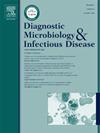Modeling the economic impact of different testing strategies for meningitis/encephalitis in adult patients from a us hospital perspective
IF 2.1
4区 医学
Q3 INFECTIOUS DISEASES
Diagnostic microbiology and infectious disease
Pub Date : 2025-04-27
DOI:10.1016/j.diagmicrobio.2025.116869
引用次数: 0
Abstract
Introduction
Meningitis and encephalitis (ME) are life-threatening conditions whose severity vary by etiology. Often, patients with suspected ME are unnecessarily hospitalized and treated with empiric therapy while clinicians determine etiology. ME diagnosis and treatment algorithms vary across hospitals, with some using a battery of rapid diagnostic tests (RDTs) or multiplex/syndromic testing, and others relying only on bacterial culture and send-out tests.
Aim
We modeled the economic impact of 4 ME testing strategies from a US hospital perspective.
Methods
A synthetic sample of 20,000 suspected ME cases was generated based on published ME etiology distribution. A Monte Carlo model simulated diagnosis, treatment, and resource use/costs from a US community hospital perspective in 4 scenarios: syndromic testing, syndromic testing in conjunction with RDTs, a battery of 4 RDTs, and off-site-only testing. Mean inpatient resource use and cost per suspected ME case were estimated. Sensitivity analyses were conducted.
Results
Mean (95% confidence interval [CI]) cost per suspected ME case was $15,465 ($15,285-$15,644) with syndromic testing, $15,720 ($15,536-$15,903) under conjunction testing, $16,412 ($16,226-$16,598) with the battery of 4 RDTs, and $19,337 ($19,150-$19,525) with off-site-only testing. Cost savings were driven by reductions in hospital stay from reduced time to correct pathogen identification. Test performance characteristics and time to pathogen identification had the largest impact on modeled costs.
Conclusion
Using the battery of 4 RDTs or syndromic testing would result in cost savings for hospitals currently not using RDTs. Syndromic testing would yield additional savings over the battery of 4 RDTs by further shortening hospital stays.
Summary
A simulation model estimated that syndromic testing would result in cost savings of $947-$3,873 compared with rapid diagnostic testing and off-site-only testing from a US hospital perspective, through reductions in length of stay, due to more timely pathogen diagnosis.
从美国医院的角度对成人脑膜炎/脑炎不同检测策略的经济影响进行建模
脑膜炎和脑炎(ME)是危及生命的疾病,其严重程度因病因而异。通常,在临床医生确定病因时,疑似ME的患者不必要地住院并接受经验性治疗。ME的诊断和治疗算法因医院而异,一些医院使用一系列快速诊断测试(RDTs)或多重/综合征测试,而其他医院仅依赖于细菌培养和发送测试。我们从美国医院的角度对4种ME测试策略的经济影响进行了建模。方法根据已发表的ME病原学分布,生成2万例疑似ME病例的合成样本。蒙特卡罗模型从美国社区医院的角度模拟了4种情况下的诊断、治疗和资源使用/成本:综合征检测、综合征检测与rdt结合、一组4个rdt和仅场外检测。估计每个疑似ME病例的平均住院资源使用和费用。进行敏感性分析。结果每例疑似ME病例的平均(95%置信区间[CI])成本为综合征检测15,465美元(15,285- 15,644美元),联合检测15,720美元(15,536- 15,903美元),4组随机对照试验16,412美元(16,226- 16,598美元),非现场检测19,337美元(19,150- 19,525美元)。由于减少了正确病原体鉴定所需的住院时间,从而节省了费用。测试性能特征和病原体鉴定时间对模型成本影响最大。结论采用4组随机对照试验或综合征检测可为目前未采用随机对照试验的医院节省成本。通过进一步缩短住院时间,综合征检测将在4个随机对照试验的基础上产生额外的节省。一个模拟模型估计,从美国医院的角度来看,由于病原体诊断更及时,住院时间缩短,与快速诊断测试和非现场检测相比,综合征检测将节省947- 3,873美元的成本。
本文章由计算机程序翻译,如有差异,请以英文原文为准。
求助全文
约1分钟内获得全文
求助全文
来源期刊
CiteScore
5.30
自引率
3.40%
发文量
149
审稿时长
56 days
期刊介绍:
Diagnostic Microbiology and Infectious Disease keeps you informed of the latest developments in clinical microbiology and the diagnosis and treatment of infectious diseases. Packed with rigorously peer-reviewed articles and studies in bacteriology, immunology, immunoserology, infectious diseases, mycology, parasitology, and virology, the journal examines new procedures, unusual cases, controversial issues, and important new literature. Diagnostic Microbiology and Infectious Disease distinguished independent editorial board, consisting of experts from many medical specialties, ensures you extensive and authoritative coverage.

 求助内容:
求助内容: 应助结果提醒方式:
应助结果提醒方式:


